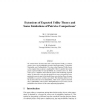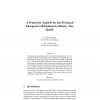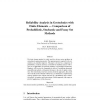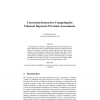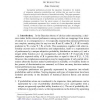ISIPTA
2003
IEEE
14 years 4 months ago
2003
IEEE
We contrast three decision rules that extend Expected Utility to contexts where a convex set of probabilities is used to depict uncertainty: Γ-Maximin, Maximality, and E-admissib...
ISIPTA
2003
IEEE
14 years 4 months ago
2003
IEEE
The European call option prices have well-known formulae in the Cox-RossRubinstein model [2], depending on the volatility of the underlying asset. Nevertheless it is hard to give ...
ISIPTA
2003
IEEE
14 years 4 months ago
2003
IEEE
The finite element method is widely used for solving various problems in geotechnical engineering practice. The input parameters required for the calculations are generally impre...
ISIPTA
2003
IEEE
14 years 4 months ago
2003
IEEE
Upper and lower conditional probabilities assigned by Hausdorff outer and inner measures are given; they are natural extensions to the class of all subsets of Ω=[0,1] of finite...
ISIPTA
2003
IEEE
14 years 4 months ago
2003
IEEE
A generalization of deFinetti’s Fundamental Theorem of Probability facilitates coherent assessment, by iterated natural extension, of imprecise probabilities or expectations, co...
ISIPTA
2003
IEEE
14 years 4 months ago
2003
IEEE
We discuss two approaches for choosing a strategy in a two-player game. We suppose that the game is played a large number of rounds, which allows the players to use observations o...
ISIPTA
2003
IEEE
14 years 4 months ago
2003
IEEE
The nature of much information available to decision makers is vague and imprecise, be it information for human managers in organisations or for process agents in a distributed co...
ISIPTA
2003
IEEE
14 years 4 months ago
2003
IEEE
ISIPTA
2003
IEEE
14 years 4 months ago
2003
IEEE
Kuznetsov’s condition says that variables X and Y are independent when any product of bounded functions f(X) and g(Y) behaves in a certain way: the interval of expected values E...
ISIPTA
2003
IEEE
14 years 4 months ago
2003
IEEE
Set-valued estimation offers a way to account for imprecise knowledge of the prior distribution of a Bayesian statistical inference problem. The set-valued Kalman filter, which p...
